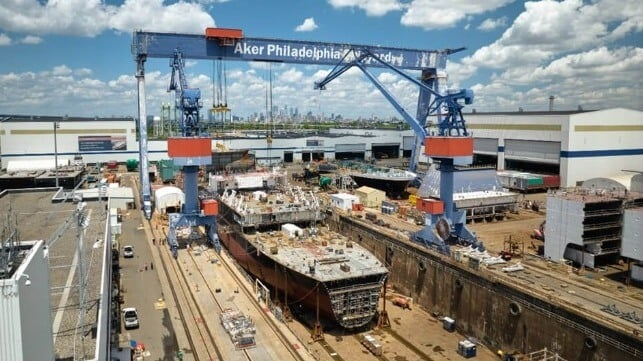On July 21, Hanwha Shipping, a US shipping company affiliated with Hanwha Group, announced that it had placed an order with Hanwha Philly Shipyard for 1+1 174,000 cbm LNG carriers. The vessels will be equipped with membrane containment systems provided by France’s GTT and M-type electronically controlled gas injection (MEGI) engines.

This will be the first time the US has built an LNG carrier in 45 years, and the first vessel is expected to be delivered in the first half of 2028. The price of each vessel is about US$250 million, which is comparable to the cost of building a vessel in Asian shipyards.
It is worth mentioning that in 2022, US shipowner Matson ordered three 3,600 TEU container ships from Philly Shipyard, with each ship costing as much as US$330 million. As a feeder container ship project, this order is considered an extremely high-priced contract globally.
However, the latest LNG carrier with high added value and high construction technology requirements only costs US$250 million.
Not only that, Matson’s first feeder container ship was started construction in 2024 and is scheduled for delivery in 2026, taking four years from signing to delivery.
The newly signed LNG carrier is scheduled for delivery in the first half of 2028, leaving the shipyard with a significantly shorter construction period. Despite the technical support from Hanwha Ocean, it remains to be seen whether Hanwha Philly Shipyard will be able to deliver the ship on time and within budget.
As is well known, budget overruns and delivery delays in shipbuilding projects at US shipyards are commonplace.
Hanwha Shipping said the project will adopt a joint construction model, with Hanwha Philly Shipyard signing the main shipbuilding contract and cooperating with Hanwha Ocean to execute it. Although a “substantial portion” of the construction work will be carried out at Hanwha Ocean’s Geoje Shipyard in South Korea, Hanwha Philly Shipyard will be responsible for US regulatory compliance and safety certification. It is worth noting that the above-mentioned LNG carriers will not comply with the Jones Act.
Through the joint construction model, Hanwha Ocean plans to gradually transfer its advanced shipbuilding technology to Hanwha Philly Shipyard, enabling the latter to expand into more high value-added ship markets.
Shortly before Hanwha Shipping announced its new shipbuilding plan, the company announced its intention to reflag LNG carriers built by Korean shipyards to the US flag. The plan will utilize the Alternative Compliance Program (ACP) agreed upon by the US Coast Guard and certain classification societies for inspection and certification.
However, after changing to US flag, the relevant LNG carriers are still limited to international voyages and do not meet the requirements of the US Jones Act, as they were not built in US shipyards. Although there are small exemptions for LNG carriers traveling between the US mainland and Puerto Rico, there are almost no vessels that meet the conditions.
Therefore, the South Korean shipbuilding industry is closely monitoring the Jones Act Repeal Act (U.S. Waters Opening Act). If passed, vessels built by overseas shipyards will also be able to sail within the United States, which means that lower-cost vessels built by South Korean shipyards can be deployed in US domestic trade.


